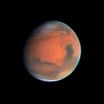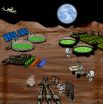(Press-News.org) Does synthetic biology hold the key to manned space exploration of Mars and the Moon? Berkeley Lab researchers have used synthetic biology to produce an inexpensive and reliable microbial-based alternative to the world's most effective anti-malaria drug, and to develop clean, green and sustainable alternatives to gasoline, diesel and jet fuels. In the future, synthetic biology could also be used to make manned space missions more practical.
"Not only does synthetic biology promise to make the travel to extraterrestrial locations more practical and bearable, it could also be transformative once explorers arrive at their destination," says Adam Arkin, director of Berkeley Lab's Physical Biosciences Division (PBD) and a leading authority on synthetic and systems biology.
"During flight, the ability to augment fuel and other energy needs, to provide small amounts of needed materials, plus renewable, nutritional and taste-engineered food, and drugs-on-demand can save costs and increase astronaut health and welfare," Arkin says. "At an extraterrestrial base, synthetic biology could even make more effective use of the catalytic activities of diverse organisms."
Arkin is the senior author of a paper in the Journal of the Royal Society Interface that reports on a techno-economic analysis demonstrating "the significant utility of deploying non-traditional biological techniques to harness available volatiles and waste resources on manned long-duration space missions." The paper is titled "Towards Synthetic Biological Approaches to Resource Utilization on Space Missions." The lead and corresponding author is Amor Menezes, a postdoctoral scholar in Arkin's research group at the University of California (UC) Berkeley. Other co-authors are John Cumbers and John Hogan with the NASA Ames Research Center.
One of the biggest challenges to manned space missions is the expense. The NASA rule-of-thumb is that every unit mass of payload launched requires the support of an additional 99 units of mass, with "support" encompassing everything from fuel to oxygen to food and medicine for the astronauts, etc. Most of the current technologies now deployed or under development for providing this support are abiotic, meaning non-biological. Arkin, Menezes and their collaborators have shown that providing this support with technologies based on existing biological processes is a more than viable alternative.
"Because synthetic biology allows us to engineer biological processes to our advantage, we found in our analysis that technologies, when using common space metrics such as mass, power and volume, have the potential to provide substantial cost savings, especially in mass," Menezes says.
In their study, the authors looked at four target areas: fuel generation, food production, biopolymer synthesis, and pharmaceutical manufacture. They showed that for a 916 day manned mission to Mars, the use of microbial biomanufacturing capabilities could reduce the mass of fuel manufacturing by 56-percent, the mass of food-shipments by 38-percent, and the shipped mass to 3D-print a habitat for six by a whopping 85-percent. In addition, microbes could also completely replenish expired or irradiated stocks of pharmaceuticals, which would provide independence from unmanned re-supply spacecraft that take up to 210 days to arrive.
"Space has always provided a wonderful test of whether technology can meet strict engineering standards for both effect and safety," Arkin says. "NASA has worked decades to ensure that the specifications that new technologies must meet are rigorous and realistic, which allowed us to perform up-front techno-economic analysis."
The big advantage biological manufacturing holds over abiotic manufacturing is the remarkable ability of natural and engineered microbes to transform very simple starting substrates, such as carbon dioxide, water biomass or minerals, into materials that astronauts on long-term missions will need. This capability should prove especially useful for future extraterrestrial settlements.
"The mineral and carbon composition of other celestial bodies is different from the bulk of Earth, but the earth is diverse with many extreme environments that have some relationship to those that might be found at possible bases on the Moon or Mars," Arkin says. "Microbes could be used to greatly augment the materials available at a landing site, enable the biomanufacturing of food and pharmaceuticals, and possibly even modify and enrich local soils for agriculture in controlled environments."
The authors acknowledge that much of their analysis is speculative and that their calculations show a number of significant challenges to making biomanufacturing a feasible augmentation and replacement for abiotic technologies. However, they argue that the investment to overcome these barriers offers dramatic potential payoff for future space programs.
"We've got a long way to go since experimental proof-of-concept work in synthetic biology for space applications is just beginning, but long-duration manned missions are also a ways off," says Menezes. "Abiotic technologies were developed for many, many decades before they were successfully utilized in space, so of course biological technologies have some catching-up to do. However, this catching-up may not be that much, and in some cases, the biological technologies may already be superior to their abiotic counterparts."
INFORMATION:
This research was supported by the National Aeronautics and Space Administration (NASA) and the University of California, Santa Cruz.
Lawrence Berkeley National Laboratory addresses the world's most urgent scientific challenges by advancing sustainable energy, protecting human health, creating new materials, and revealing the origin and fate of the universe. Founded in 1931, Berkeley Lab's scientific expertise has been recognized with 13 Nobel prizes. The University of California manages Berkeley Lab for the U.S. Department of Energy's Office of Science. For more, visit http://www.lbl.gov.
Berlin, Germany (November, 2014) - The dodo is among the most famous extinct creatures, and a poster child for human-caused extinction events. Despite its notoriety, and the fact that the species was alive during recorded human history, little is actually known about how this animal lived, looked, and behaved. A new study of the only known complete skeleton from a single bird takes advantage of modern 3-D laser scanning technology to open a new window into the life of this famous extinct bird. The study was presented at the 74th Annual Meeting of the Society of Vertebrate ...
Berlin, Germany (November, 2014) - Many large charismatic mammals went extinct at the end of the Ice Age (approx 11,000 years ago), including the Steppe bison, Bison priscus. A recent find in Eastern Siberia has uncovered one of these bison, literally, frozen in time.
The most complete frozen mummy of the Steppe bison yet known, dated to 9,300 years before present, was recently uncovered in the Yana-Indigirka Lowland and a necropsy was performed to learn about how this animal lived and died at the end of the Ice Age. The Yukagir bison mummy, as it is named, has a complete ...
There is no doubt that pregnant and breastfeeding women try to do everything they can to ensure a healthy outcome for their baby, including eating a healthy, well-balanced diet that provides the necessary nutrients for fetal growth and development. In recent years, there has been significant debate about the consumption of fish among pregnant and breastfeeding women.
In June, following a survey that found that the majority of pregnant women do not eat much fish and thus may have inadequate intake of certain omega 3 fatty acids, the Food and Drug Administration (FDA) ...
COLUMBUS, Ohio - The health benefits of over-the-counter curcumin supplements might not get past your gut, but new research shows that a modified formulation of the spice releases its anti-inflammatory goodness throughout the body.
Curcumin is a naturally occurring compound found in the spice turmeric that has been used for centuries as an Ayurvedic medicine treatment for such ailments as allergies, diabetes and ulcers.
Anecdotal and scientific evidence suggests curcumin promotes health because it lowers inflammation, but it is not absorbed well by the body. Most curcumin ...
BOSTON - (November 6, 2014) - Mary R. Loeken, Ph.D., Investigator in the Section on Islet Cell and Regenerative Biology at Joslin Diabetes Center and Associate Professor of Medicine at Harvard Medical School, has discovered a molecular pathway responsible for neural tube defects in diabetic pregnancies. Her latest research findings in this pathway were published in the October issue of Diabetes.
For 20 years, scientists have known of a gene involved in neural tube defects (such as spina bifida), but until now it was not known exactly what causes this gene to malfunctions ...
The modern sequencing techniques have shown that bats can carry a bacterial species previously been shown to cause deadly human infections in USA.
When the research group of Arto Pulliainen at the Department of Biosciences, University of Helsinki, Finland, analyzed an array of bat samples from Finland and UK, one class of identified bacteria turned out to be exceptionally significant. Multilocus sequence analyses of clonal bat Bartonella isolates demonstrated that bats carry Bartonella mayotimonensis. This species has previously been shown to cause deadly human infections ...
MANHATTAN, KANSAS -- A Kansas State University psychological sciences professor is using twin studies to understand the nature versus nurture debate of the workplace: Do genetic factors or environmental factors influence employee proactivity?
His answer: The interaction between the genetic and environmental factors determines why some employees are more proactive than others.
"It's more like nature and nurture rather than nature versus nurture," said Wendong Li, assistant professor of psychological sciences in the College of Arts & Sciences. "It is the reciprocal relationship ...
For decades, scientists have been perfecting models of how contagions spread, but newly published research takes the first steps into building a model that includes the loop linking individual human behavior and the behavior of the epidemic itself.
The first results of the highly complex modeling led by researchers at the New York University Polytechnic School of Engineering were recently spotlighted as "brilliant research" by the American Physical Society.
Eventually, the team hopes the model will more accurately predict who should be vaccinated and isolated first ...
By combining projections of climate change, emissions reductions and changes in land use across the USA, an international research team estimate that by 2050, cumulative exposure to ozone during the summer will be high enough to damage vegetation.
Although the research findings - published in Atmospheric Chemistry and Physics Discussions - focus on the impact in the USA, they raise wider concerns for global air quality, according to lead researcher Dr Maria Val Martin, from the University of Sheffield's Faculty of Engineering
"Modelling future air quality is very complex, ...
The dreaded scratch or puncture test is the most common way of assessing allergic reactions to as many as 40 different substances at once. But because the test involves needles that prick multiple points along the skin's surface, it's a particularly high-stress examination for children -- and their understandably anxious parents.
A new study by Tel Aviv University researchers provides the first quantitative analysis of the role of "medical clowns" in assuaging the anxiety and pain felt by children undergoing allergy tests. The research, published in Allergy, was conducted ...




